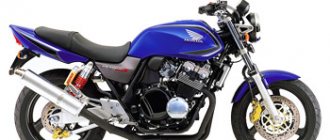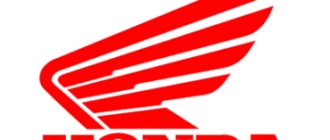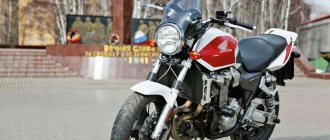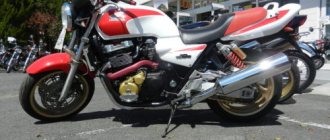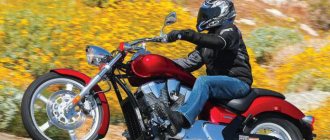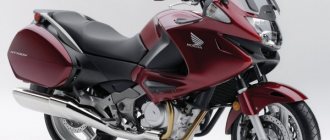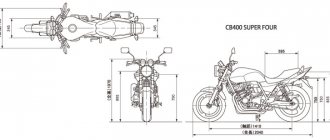Bike features
Here are the main features of the Honda CB 1300:
- spacious fuel tank;
- availability of versions with ABS;
- powerful front brakes.
This motorcycle is one of the few modern representatives of the class that optimally corresponds to a classic bike in the full sense. This is neither an ultra-modern option with perfectly streamlined shapes, nor a retro classic, but something completely universal.
Technical characteristics of Honda CB 1300
| Engine | Four-cylinder, four-stroke, 115 hp, 1284 m3 |
| Cooling type | Vodyanoye |
| Fuel supply | Injection |
| Lubrication method | Oil pan |
| Ignition type | Digital |
| checkpoint | Sequential, five-stage |
| Drive unit | Chain |
| Suspension | Telescopic cartridge fork at front Double-sided shock absorber at rear |
| Brake | Two discs at the front One disc at the rear |
| Dimensions (LxWxH) | 2220x790x1215 mm |
| Clearance | 135 mm |
| Weight | 226 kg |
| Tank | 21 l |
One of the most popular varieties of this model is the Honda CB 1300 Super Four line. Her appearance did not symbolize anything new. Quite the contrary - the engineers made every effort to preserve the image of a classic roadster. A standard road frame, a minimum of plastic elements, a round headlight located under the analogue instrument panel - an accurate description of the Super Four.
Engine
The Honda SB 1300 has an in-line engine, which is four-stroke and four-cylinder. Its effective capacity is 1284 cm³. This unit is cooled by liquid. Peak performance is as follows: torque will be 116.7 Nm, while power will be 115 hp. The speed at its peak is 220 km/h. Acceleration to hundreds is achieved in 3.5 seconds, but you should be careful when accelerating on this model.
Road classic Honda cb1300sf
The first generation Honda CB1300SF began production in 1998 only for the Japanese market. Then, in 1999, the model added fork preload adjustment and a stand. In 2000, the calipers take on the gold and silver color of the radiators. And 2001 was marked by an improvement in the fuel system, which significantly reduced consumption.
In 2003, the second generation was released, which became available in Europe and Oceania. The carburetor is replaced with an injector, power increases, torque decreases. A new lightweight frame, smaller tires, and a new instrument panel are installed. The weight of transport is reduced.
The release of the modified Super Bold'Or marks 2005. Further, in 2008, a new catalyst and a matte gray metallic engine were installed in the model. And in 2010 they released Super Touring with increased generator capacity. It is still in production without any major changes.
According to official data, the fuel consumption of the Honda cb1300 for every 100 kilometers of road is 4-4.63 liters at a driving speed of about 60 km/h. But the real figure is several liters higher. Also, a lot depends on the style and average driving speed.
Model range Honda CB1300sf
The first generation of the Honda SV 1300 motorcycle was produced for the Japanese market. The design of the bike was no different from the SV 1000. And the power of the carburetor engine was 100 horsepower. In 2001, they began producing 4-piston calipers, replacing 6-piston ones. The feathers built into the fork have a diameter of 4.5 cm. The weight of such a Honda is from 270 to 275 kilograms, quite a bit heavier than the Honda cbf 1000, which weighs 252 kg.
The second generation has five-spoke wheel rims, and the appearance of the power plant is updated. And instead of a carburetor, an injection engine with a capacity of 115 horsepower begins to be used. Its weight is 252 kg.
In 2005, they began producing the Honda Super Bold'Or, which has fairings in front, glove compartments on the sides and straight-line headlights. And in 2009, a sports-touring Super Touring weighing 284 kilograms with a new exhaust system.
Comparison with analogues and competitors
The main competitors of the CB 1300 are Kawasaki ZRX 1200, Suzuki GSF 1200 and Yamaha XJR 1300.
If you compare Honda with Yamaha, the latter is inferior in its technical characteristics. The Honda has more power and is more modernized. Yamaha has a lot of advantages. For example, good style and a sufficient number of models on our market. But, compared to Honda, it is softer in nature.
Pros and cons of the Honda CB1300sf
The Honda SV 1300 motorcycle has many characteristics similar to a sports one. It can accelerate to 100 km/h in 3.5 seconds and reaches top speed very quickly. But the suspension is not designed for such loads, so you can feel jerks when accelerating.
Although the motorcycle is quite practical, its weight often causes some inconvenience, especially for novice riders. The problem is that all the weight is located at the top of the motorcycle. Therefore, it can be difficult to move around the city, since you need to constantly stop and drive at low speed.
It is much better to drive a motorcycle outside the city on the highway, where the bike behaves quite confidently at high speed. The large tank eliminates the need for frequent refills.
Reviews from Honda CB1300sf owners
Reviews from Honda 1300 owners are in most cases positive, as the equipment operates silently. The deformed in-line engine accelerates smoothly from any speed in any gear and has smooth traction. If you adjust the gaps in time, you can avoid repairs for a long time. A noticeable disadvantage is that fuel consumption is 7-10 liters during standard driving.
The experience of operating a motorcycle over a long distance was successful. For long trips, the Honda seat is completely suitable. Driving does not cause any inconvenience, especially when driving on the highway, where the motorcycle behaves quite confidently and the chassis is tolerable. The controllability of this technique is acceptable.
Tuning Honda CB1300sf
There are no problems with tuning a Honda, since there are many companies that produce spare parts for this model, including windshields and panniers. You can find suitable tuning for both the first generation (intended only for the Japanese market) and the second. Body kits that are suitable for one generation may not be suitable for the second, so you need to be careful when purchasing.
Approximate prices for motorcycle parts when replacing them during repairs:
- Air filter: RUB 2,000;
- Set of silent blocks: RUB 2,400;
- Set of forks (not original): RUB 3,500;
- Rear shock absorbers: RUB 62,000;
- Safety bars (not original): RUB 5,140.
Technical characteristics of the Honda CB1300sf motorcycle model
Engine:
- sixteen valve;
- four-cylinder;
- in-line;
- DOCH liquid cooled system;
- volume is 1284 cm3;
- piston stroke and cylinder bore: 78 mm × 67.2 mm;
- 1000 rpm per minute of idling;
- maximum power: 85 kW at 7,500 rpm;
- maximum torque of 117 newton meters at 6,000 rpm;
- oil capacity - 4 liters.
Fuel system:
- 3.6 cm throttle diameter;
- PGM-FI power system;
- cartridge type paper air filter;
- Fuel tank capacity: 21 liters + reserved 4.5 liters.
Electrical system:
- electric starter;
- alternator: 420 volt power;
- 1° ignition timing at idle;
- 46° ignition timing at 3,500 rpm;
- Headlight lighting: low 12 V, 55 W, high 60 W.
The weight of the Honda 1300 motorcycle is 249-273 kilograms.
The maximum speed is 240 km/h, and it can accelerate to 100 km/h in 3.5 seconds.
Dimensions and weight
The model reaches 2220 mm in length, 790 mm in width, and 1120 mm in height. The seat height here is 780 mm, while the wheelbase is 1515 mm. Without fuel, the bike weighs 224 kg, and its tank capacity is 21 liters. Gasoline consumption greatly depends on driving style, but the motorcycle stubbornly refuses to consume less than 7 liters per hundred kilometers.
Chassis and brakes
The frame of the machine is made of steel, and the type is duplex. The wheels on this model are alloy, and the steering wheel is typical for the class. In general, the exterior looks impressive, no less catchy than many motorcycles with a much more modern look.
The rear suspension is pendulum and equipped with two shock absorbers. This is a completely typical solution for such a motorcycle. At the front there is a 43 mm telescopic fork. The rear brake is represented by a single-piston caliper and a 276 mm disc, and the front has four-piston calipers and a pair of 310 mm discs. Such a braking system should probably be sufficient at high speeds.
Suzuki GSX 1300 BK B - King (2007–2012, 450,000–650,000 rub.)
In the case of the King, the engineers were clearly influenced by something very ambitious. Building a naked bike based on the Suzuki GSX 1300 R Hayabusa hyperbike is an idea on the brink. But what happened was what happened. Moderately brutal, very monumental and ambiguous. The consumer did not try the model right away. The popularity of the Suzuki GSX 1300 BK B - King came after it was discontinued.
Engine
The powerful four-cylinder in-line engine with a displacement of 1340 cm3, liquid cooling, two rows of intake nozzles (SDTV) and an engine traction management system (S-DMS) was completely repainted in black during the inheritance process and smothered to 184 hp. With. at peak at 9500 rpm and 146 Nm at peak at 7200 rpm (versus 197 hp at 9500 rpm and 155 Nm at 7200 rpm for the Busa, respectively) with brains, exhaust and intake ports in airbox.
This particular power unit, even in a format that is much more provocative for driving well beyond 200 km/h, Suzuki Hayabusa lives a long time and is relatively problem-free. Inside the “King” its resource can be safely multiplied by two. In global practice, stock motors from B-King that died by natural causes are not found. The tendency to waste oil is small - up to 1 liter from replacement to replacement when driving in "war" mode. In the context of service, B-King does not present any surprises; all operations are obvious and unified.
Transmission
The massive clutch in an oil bath, even despite the violent temper of the engine and the prohibitive mass of the motorcycle for naked bikes, lives happily ever after. Destructive destruction occurs only when a novice or stunt rider gets behind the wheel. A drive chain, even a reinforced one, lasts no more than 15,000–17,000 km for active driving.
Frame and body kit
The two-section frame is absolutely its own. The design, it should be noted, is monumental! It is distinguished from the hyperbike frame by indirect sidewalls and a smaller amount of “meat” in the area where the rear subframe is attached.
Regarding the appearance, the Suzuki B-King is unique in its entirety and in every detail. The designers did not pursue the desire to make the naked bike as compact as possible. Quite the contrary – the motorcycle is very large! When searching for exterior parts to replace those worn out due to a fall, there is a chance of epic suffering.
Brakes
At the time of its introduction, the King's brakes were considered the best among the entire GSX1300 family. The single-piston caliper on the rear wheel is exactly the same as on the Hayabusa and Jixers. Two Nissin four-piston calipers radially mounted on discs with a diameter of 310 mm, together with a radial GTZ, are an unaffordable luxury specifically for the GSX 1300 family! The naked, which is strange, seriously over-brakes the hyperbike. Especially considering that the B-King had an anti-lock brake system much earlier. In nature there is also a configuration without ABS.
Pendants
The rear swingarm is quite long. The wheelbase of the Suzuki GSX 1300 B - King is 1525 mm. For comparison: the Suzuki GSX 1300 R Hayabusa has 1480 mm. The upper U-shaped traverse is thinner - only one tension bolt on each side, the lower one is more powerful - three bolts on each side. The dimensions of the front tires of the “King” and “Busa” are the same, the rear tires of the B - King are wider - 200/50-17 versus 190/50-17.
Comfort
For a naked bike, the Suzuki GSX1300BK B-King is too big and powerful, for a power cruiser it is too “sharp” in terms of chassis and engine. We get a kind of hybrid - a power naked... The main beauty of this non-format is the absence of problems with torque. There is no need to crank the engine up. Traction is always at hand. Here and now. The driver of a Suzuki B-King with the instinct of self-preservation turned off by default in traffic and at traffic light starts will force anyone to swallow dust from under their wheels. At the same time, the large and massive “King” is not deprived of decent aerodynamics. Up to 200 km/h the driver can sit quietly with an almost straight back.
Modifications
The first concept was shown in 2001 at the Tokyo Motor Show. Serial production of the B-King began only in 2007. The motorcycle was removed from the assembly line in 2012. For five years the design has remained almost unchanged. In 2010, there were minor cosmetic changes - the traditional Suzuki blue and white livery with gold rims appeared. There was also a limited edition Suzuki B-King Bumble Limited Edition, which featured a Chevrolet Camaro-style yellow paint job, a full Yoshimura exhaust and a set of additional plastic trim.
History of changes
During its career, this motorcycle went through several stages:
- 1998 – launch of production, first generation;
- 1999 – the central stand appears;
- 2001 – reduction in fuel consumption;
- 2003 – second generation, global changes;
- 2008 – new catalyst.
Since then, the CB 1300 has not changed much. This motorcycle is perfect for connoisseurs of the best that has been tested for decades, because it has everything to evoke the best memories of motorcycle riding veterans. Taking all the best from the old school, the model meets modern standards.
